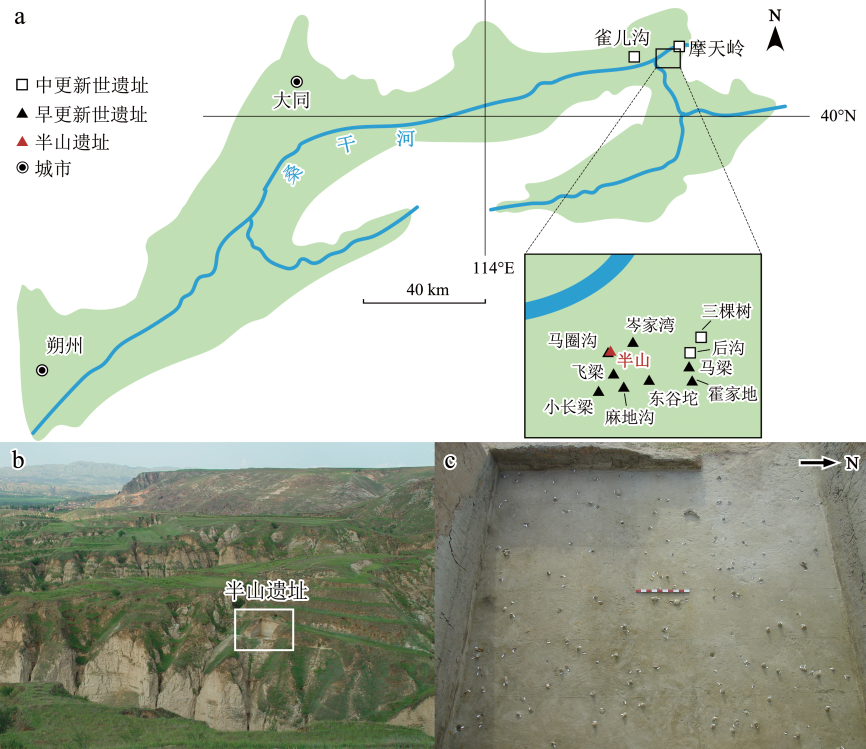

泥河湾盆地半山遗址2003年出土的石制品
收稿日期: 2023-01-09
录用日期: 2024-03-24
网络出版日期: 2025-04-15
基金资助
国家重点研发计划项目(2020YFC1521500);国家自然科学基金项目(42177424);中国科学院青年促进会(2020074);中国科学院地质与地球物理研究所重点部署项目(IGGCAS-201905)
The stone artifacts of 2003 excavation at Banshan site in the Nihewan Basin
Received date: 2023-01-09
Accepted date: 2024-03-24
Online published: 2025-04-15
半山遗址地处泥河湾盆地东缘,于1990年发现并展开试掘,出土了少量石制品和动物化石。2003年,为全面揭示遗址文化面貌,河北省文物研究所与阳原县文物保护管理所联合对半山遗址展开新的考古发掘,发掘面积42 m2,出土421件石制品和1600余件动物化石。出土石制品原料以燧石为主,火山角砾岩次之;类型包括剥片产生的石核及石片、工具、砾石、岩块、断块和碎屑等。剥片技术以锤击法为主,砸击法为辅;工具修理较为简易,修理程度不高。根据现有古地磁年代序列和地层关系判断,古人类在该遗址活动的时间大致为1.32 Ma,略晚于小长梁遗址。此次发掘工作补充了半山遗址的石制品材料,拓展了我们对该遗址的认识。

李燊 , 任雪岩 , 刘连强 , 杨石霞 , 岳健平 , 王法岗 . 泥河湾盆地半山遗址2003年出土的石制品[J]. 人类学学报, 2025 , 44(02) : 193 -200 . DOI: 10.16359/j.1000-3193/AAS.2024.0058
The Nihewan Basin in North China is one of the most important palaeoanthropological archives in Asia as it preserves an abundance of mammal fossils and lithic assemblages. In particular, a series of sites are dated to between the Gauss-Matuyama and Matuyama-Brunhes geomagnetic reversals (2.58~0.78 Ma), making the Nihewan Basin an ideal region to examine Early Pleistocene archaeological sites and technological trends in eastern Asia. Here we describe the lithic assemblage from the Banshan site in the Nihewan Basin, which is dated to 1.32 Ma by paleo-magnetic dating.
The Banshan site (114°39′47″E, 40°13′32″N, 858 m asl) is located in the northern upper part of the Majuangou site, about 1.5 km southwest of the Cenjiawan village in Yangyuan County, Hebei Province. The site was discovered and test excavated in 1990 and yielded a few remains. In order to reveal cultural features of the site integrally, formal excavation was undertaken in 2003. A total of 42 m2 was exposed, uncovering 421 stone artifacts and more than 1600 pieces of animal fossils.
In terms of the Banshan lithic assemblage, raw materials were procured from the adjacent areas and predominated by chert and volcanic breccia, in addition to a small amount of andesite porphyry, quartz, dacite, andesite, and rhyolite porphyry, and so on. The artifact types of the site mainly include cores, flakes, tools, pebbles, blocks, angular fragments and shatters, etc. The artifacts are predominantly small (20≤L<50 mm) in size. Artifacts (L≥100 mm) are present in rather small amounts. The flaking technique is dominated by direct hard hammer percussion, and bipolar technique is used occasionally. There are almost no special platform preparation and shaping out of the core-to-be, indicating a simple debitage method at the site. The tools include scrapers, borers, notches and unidentified pieces. These pieces are primarily made on flakes and casually retouched by direct hammer percussion. Overall, the lithic industry of Banshan is characterized by local raw material exploitation strategy, simple core-flake debitage and expedient small flake-based tool inventory. Comparison of Banshan with other Early Pleistocene sites (e.g., Xiaochangliang, Donggutuo and Cenjiawan) indicates a flexible approach in the raw material utilization and a noticeable technological development tendency in the Nihewan Basin.

Key words: Banshan site; Nihewan basin; Lower Paleolithic; stone artifacts
| [1] | 卫奇. 泥河湾盆地半山早更新世旧石器遗址初探[J]. 人类学学报, 1994, 13(3): 223-238 |
| [2] | 谢飞, 李珺, 刘连强. 泥河湾旧石器文化[M]. 石家庄: 花山文艺出版社, 2006: 80-85 |
| [3] | 河北省文物考古研究. 河北阳原县马圈沟旧石器时代遗址2014年的发掘[J]. 考古, 2023(11): 3-19 |
| [4] | Zhu RX, Potts R, Xie F, et al. New evidence on the earliest human presence at high northern latitudes in Northeast Asia[J]. Nature, 2004, 431: 559-562 |
| [5] | Zhu RX, Hoffman KA, Potts R, et al. Earliest presence of humans in northeast Asia[J]. Nature, 2001, 413: 413-417 |
| [6] | Wang HQ, Deng CL, Zhu RX, et al. Magnetostratigraphic dating of the Donggutuo and Maliang Paleolithic sites in the Nihewan Basin, North China[J]. Quaternary Research, 2005, 64: 1-11 |
| [7] | 王红强, 邓成龙, 朱日祥, 等. 泥河湾盆地岑家湾旧石器遗址的古地磁定年[J]. 中国科学(D辑: 地球科学), 2006, (3): 273-279 |
| [8] | Yang SX, Hou YM, Yue JP, et al. The lithic assemblage of Xiaochangliang, Nihewan basin: Implications for Early Pleistocene hominin behavior in North China[J]. PLoS ONE, 2016, 11(5): e0155793 |
| [9] | Pelegrin J. Remarks about archaeological techniques and methods of knapping:elements of a cognitive approach to stone knapping[A]. In: Roux V, Bril B(eds). Stone Knapping: The Necessary Conditions for a Uniquely Hominin Behaviour[M]. Cambridge: McDonald Institute for Archaeological Research, 2005, 23-33 |
| [10] | Speth JD. Mechanical basis of percussion flaking[J]. American Antiquity, 1972, 37(1): 34-60 |
| [11] | Cotterell B, Kamminga J, Dickson FP. The essential mechanics of conchoidal flaking[J]. International Journal of Fracture, 1985, 29(4), 205-221 |
| [12] | Roche H. From simple flaking to shaping:stone knapping evolution among early hominids[A]. In: Roux V, Bril B(eds). Stone Knapping: The Necessary Conditions for a Uniquely Hominid Behaviour[M]. Cambridge: McDonald Institute for Archaeological Research, 2005, 35-48 |
| [13] | Schick KD, Toth NP. The cutting edge: new approaches to the archaeology of human origins[M]. Bloomington, IN: Stone Age Institute Press, 2009 |
| [14] | Yang SX, Wang FG, Xie F, et al. Technological innovations at the onset of the Mid-Pleistocene Climate Transition in high-latitude East Asia[J]. National Science Review, 2021, 8(1): 11 |
/
| 〈 |
|
〉 |